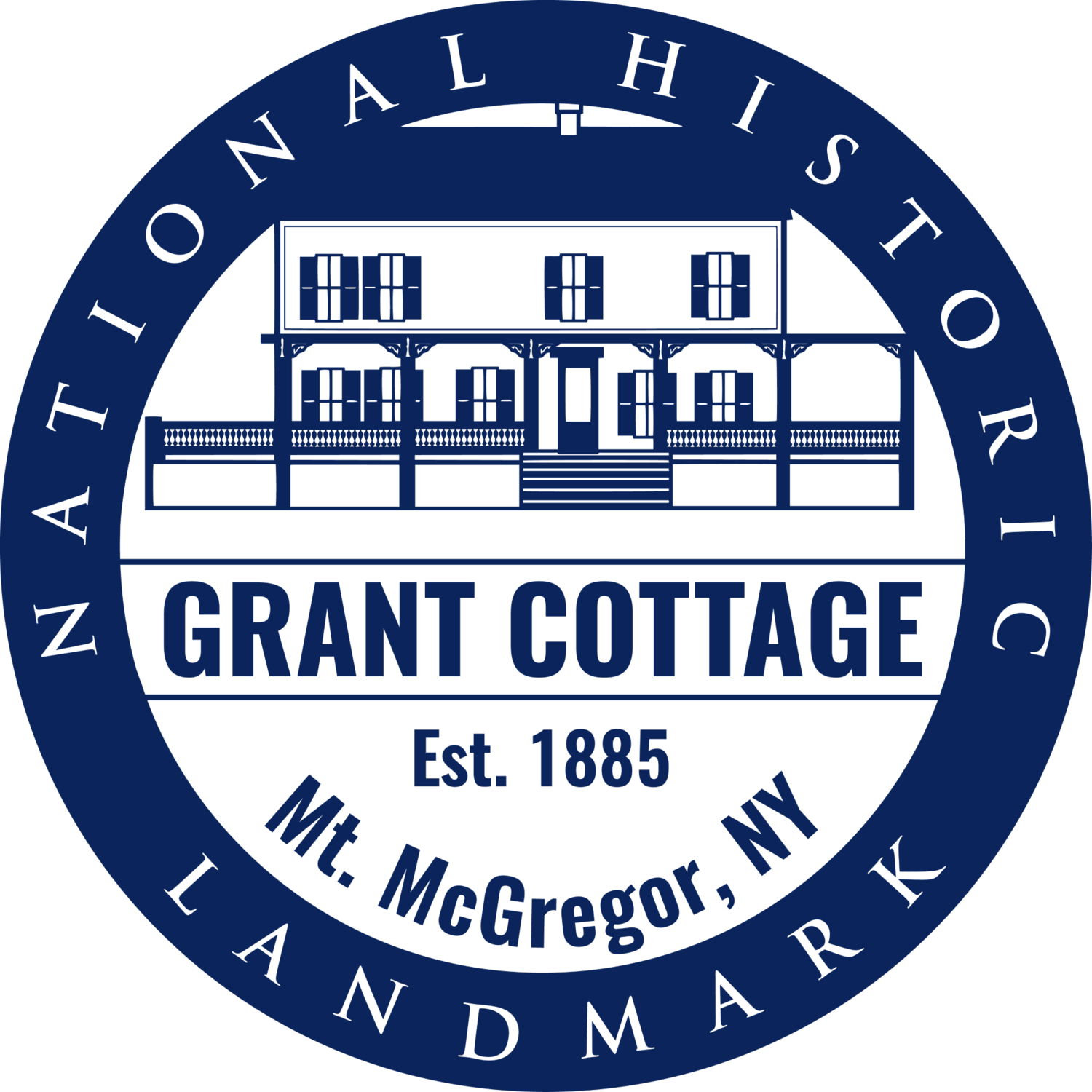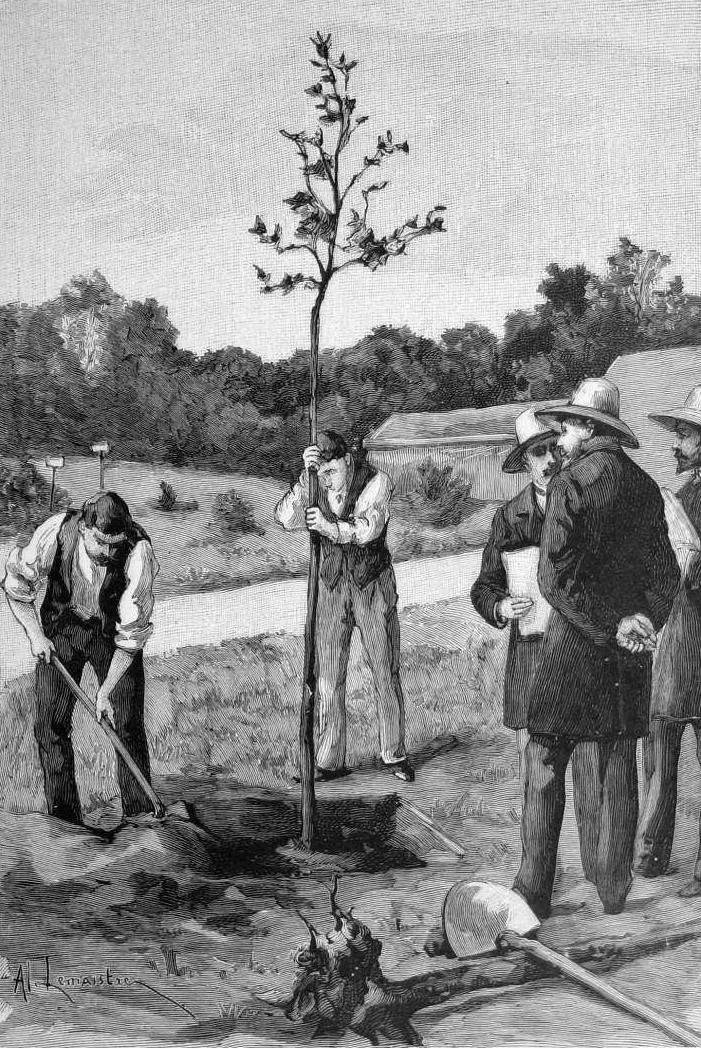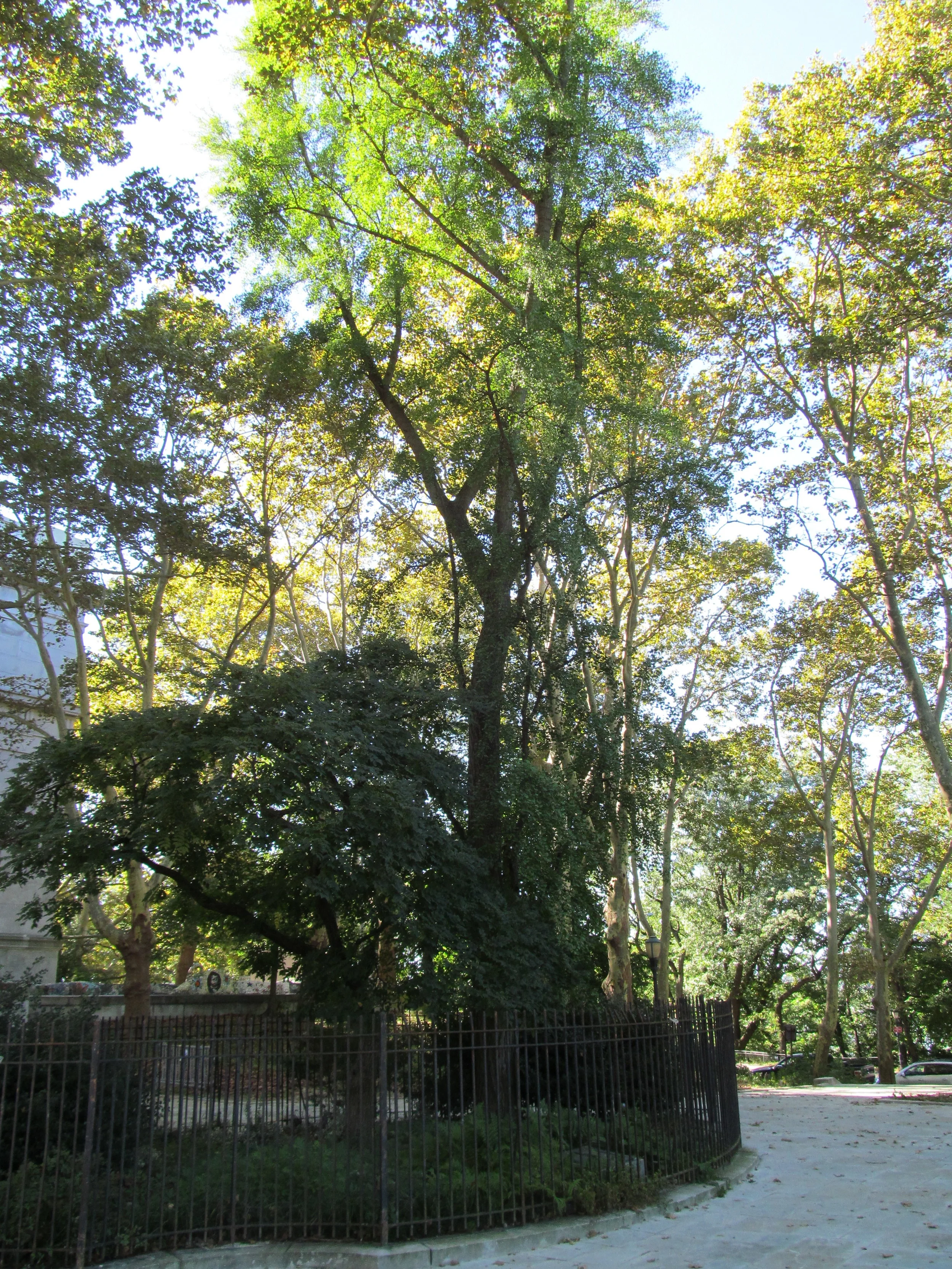Firmly Planted
By Ben Kemp, Cottage Operations Manager
“He [Grant] loved to ride through woods and note the different trees, and he knew them all, and speak of their growth and habits. He loved the growing grain and the means and processes of quickening it. He loved horses and farm animals, and a quiet, contemplative life mixed with the activity of outdoor work." -General E. F. Beale
From an early age, trees would have represented a resource to Ulysses Grant, a means to a livelihood. Grant watched from his bedroom window as the huge wagons of tanning bark came in to treat the animal hides in his fathers’ tannery across the road. He hauled logs and firewood as a young boy and wood fires burned in every hearth providing the only respite from the southern Ohio winters.
Both Ulysses and his wife Julia loved the outdoors. It fired their poetic souls and sparked their sense of wonder. During their courtship in the 1840’s, they would ride through the fields and forests outside of St. Louis, Missouri on horseback together. Grant would later be enchanted by the impressively wild forests of the northwest and northern California during his lonely days away from his young family at military outposts in the early 1850’s. He dreamed of one day returning to live in the land of the ancient redwoods and sequoias and though the dream was never realized some of these giants of the forest were named in his honor.
After resigning from the military in 1854, Grant would rely on the forests of eastern Missouri to provide a home and income for his family. He used lumber cleared from land given to his wife Julia by their father in law to build a cabin. The log cabin, with rough-hewn beams, would prove to be a testament to the thrifty pragmatism of Grant and its rough appearance would earn it the nickname Hardscrabble. When he was not working in the crop fields, Grant would take loads of firewood to town and sell it for needed income.
Trees damaged by bullets at Gettysburg
In the Civil War, Grant would watch the forests devoured before his armies, a necessary evil of warfare. The human cost of the Civil War is well known, but the environmental impact was no less staggering. The landscape was stripped bare of trees by the moving cities known as armies. Firewood, shelters, telegraph poles, railroad ties, bridges, defensive works and more ate up huge swaths of forest, millions of acres fell to the soldier's axe. Those trees that were spared the axe sometimes found themselves whittled to stumps by gunfire and cannon shot. In the devilish inferno of the Wilderness men and trees alike burned in a blaze set by the violence of battle.
Like monuments, trees as natural landmarks would be revered as memorials to significant events of Grant’s Civil War career. It was said to be under what became known as the “Grant Oak” in Ironton, Missouri that Grant received his promotion to Brigadier General in August 1861. Near the oak in 1886 a statue was erected by surviving members of Grant’s first regiment, the 21st Illinois Infantry, with the inscription “Let Us Have Peace”. A tree that Grant bivouacked under on a terrible stormy night at Shiloh, Tennessee in 1862 would eventually be toppled by a storm many years later, replaced by a monument. An apple tree near Appomattox, Virginia where Grant and Robert E. Lee supposedly discussed surrender terms under (it was actually Grant’s aides) in 1865 was cut down to the roots for souvenirs.
Trees in the present day are typically viewed as a resource to be conserved, but in Grant’s time, they were more often regarded simply as a plentiful resource for shade, beauty, or harvest. Preserving an entire expanse of forest for the benefit of the general public was a relatively new concept. On March 1, 1872 President Grant established Yellowstone National Park a 2.2 million acre park that is 80 percent forested including 9 species of conifers, a few over 1500 years old. In one section of the park are ancient fossilized tree stumps, a true natural wonder. On April 10 of the same year, Nebraska would host the first Arbor Day with an estimated 1 million trees being planted. This was the brainchild of Julius S. Morton who would inspire a movement across the nation to plant trees for the future. The tree became a symbol of hope, where seeds are planted in faith that they will grow for the benefit of future generations. Planting a tree was done with the realization that it was the start of something that would not be finished in one’s lifetime. It was a beautiful practice of faith and trust because, after planting, a tree will have to face natural forces on its own to fulfill is destiny. The one place lacking in trees was the great plains of the American west. In 1873, President Grant signed the Timber Culture Act which allowed settlers an additional 160 acres of land if they cultivated trees on at least 40 of the acres. This was designed to help solve the lack of wood for heating, building, and wind breaking on the plains. Although the act was ultimately unsuccessful, many groves of trees survive from the era it was in effect. The true beginnings of the forest conservation movement occurred during the waning years of the Grant presidency with the founding of the American Forestry Association in 1875 and the first appropriations for a federal forestry official the following year.
“He who plants a tree plants a hope.” -Lucy Larcom
President Grant showed his prowess at tree planting at his seaside retreat in Long Branch, New Jersey:
“The stables stand in a grove of evergreen and pine trees on …the [Long Branch] property. This grove was Gen. Grant's pride. He planted all the trees and took great credit to himself because he was the ‘first cottager to succeed in making trees grow so near the sea front.’ Hundreds of trees had been set out. but they all died. Gen. Grant conceived the idea of planting a lot of them together instead of singly.”
Another purpose of planting trees was for ceremony. As a public figure, Grant would frequently be requested to plant a tree in a community as a symbol of respect and hope for that community. The tree would also stand as a lasting memorial to a man regarded as a great soldier and statesman.
“The man who has neither written a book nor planted a tree, might as well never have been born-since the world, when he dies, has nothing to remember him by.” -Unknown
Grant planted an acacia tree at the National Botanical Garden in Washington DC, located where the National Mall is today. In the early 1900’s, there was a push back when it became known that a significant number of trees, planted by prominent men, would have to be removed to institute a new more open plan for the National Mall. In the end, the Grant Memorial would be erected at one end of the reconstructed Mall with slow-growing stout Burr Oaks on either side.
On a world tour spanning over 2 years, Grant would experience trees from all over the globe. In September 1877 at Stratford on Avon in England, Grant would receive an address “in a casket made out of Shakespeare’s Mulberry Tree.” The mulberry tree, presumed to have been planted by Shakespeare, was a major attraction until the 1750’s, when the owner of the property chopped it down to stop the flood of people on his property. The wood was saved and made into a multitude of souvenir and ceremonial items, an illustration of the power of celebrity status on something as ordinary as a tree. While visiting the Holy Land in 1878, Grant was taken in as he touched the old gnarled bark of the ancient olive trees in the Garden of Gethsemane, a tangible living link to a religious past. Grant’s youngest son, Jesse Grant, recalled that when they were visiting Pallanza, Italy on the shore of Lake Maggiore that their party met the beautiful American bride of a Russian prince: “She called upon us, pathetically anxious to talk of America, and invited us to breakfast. Later we drove to her villa at Intra, there father at her request planted a tree.”
In Japan, Grant and his wife, Julia, were requested to plant ceremonial trees in at least three locations:
In Nagasaki, on June 22, 1879, “…the Governor asked the General and Mrs. Grant to plant memorial trees. The species planted by the General was the Ficus religiose (Sacred Fig), while to Mrs. Grant was given the Saurus camphora (Camphor tree). The Governor then said that Nagasaki had resolved to erect a monument in honor of General Grant's visit, that this memorial would be near the trees, and that if the General would only write an inscription it would be engraved on the stone in English and Japanese characters. The General wrote the inscription as follows: ‘Nagasaki, Japan, June 22, 1879. At the request of Governor Utsumi Togatsu, Mrs. Grant and I have each planted a tree in the Nagasaki Park. I hope that both trees may prosper, grow large, live long, and in their growth, prosperity, and long life be emblematic of the future of Japan. 'U. S. GRANT’" The tree planted by Mrs. Grant was reported to have died prior to 1904 and Grant’s tree was a victim of World War II. A plaque still stands with a mulberry tree beside it.
While in Tokyo, the Grants were invited to plant trees at two different locations:
“On July 15, 1879, the Grants visited the Tokugawa’s family temple Zojoji Temple at Shiba in Tokyo and planted a [Himalayan] cedar tree which has grown to a giant tree today… on Aug. 25, 1879, the citizens of Tokyo held a fete for them at Ueno Park, which His Majesty [Emperor Meiji] was pleased to attend…During the day the Grants were each asked to plant a tree and he planted a hinoki, Lawson Cypress, and she, a gyokuran, Bull Bay (Magnolia grandiflora) at Ueno Park.”
The Tokyo plantings were at carefully chosen sites associated with modernization and were therefore symbolic of the desire for modernization in Japan. Western-style modernization in housing, agriculture, and education was encouraged by various American representatives, some from the Grant administration. The trees also served as long-lasting reminders of a respected American leader:
“Fifty years later in August 1929, Viscount Shibusawa and Baron Masuda who were the members of the original reception committee to welcome the Grants, erected a monument near the spot where the Grants planted trees [at Ueno Park] so that the history of the trees were not forgotten. They wished to have a memorial of Grant’s visit to keep his memory fresh in the minds of the Japanese people, as do the trees that are always green. A special memorial service was held at this site in 1935, on the 50th anniversary of Grant's death. Since 1946 (after WWII), special memorial services have been held at this site, in Grant's honor, every year on Memorial Day (the last Monday of May).”
Back in the States in the fall of 1879, the tree plantings would continue:
Stopping in Chicago, Illinois, where his son Fred lived, Grant planted an elm tree in South Park (now Washington Park) as a “symbol of peace and good fellowship to all.” One Hundred and fifty people were said to have come out for the ceremony and later a boulder was added with the inscription "Tree planted by Ulysses S. Grant, December 6th, 1879." The tree grew until the 1930’s when it was cut down and all that remains is the boulder. About a week later Grant stopped in Alleghany, Pennsylvania where he planted a linden tree in West Park that survived until 1908. Finally, on December 17th, Grant planted another elm tree in Independence Square in Philadelphia. The North American elm tree population would later be decimated by the Dutch elm disease in the 20th century, killing off as much as 75% of the trees.
A few years later, Grant planted a tree at his friend George W. Childs’ estate: “During one of his visits at Wootton [near Philadelphia, PA], my country-seat, he planted, on Oct. 16, 1882, an oak, and always held it in remembrance. Just before his death he asked me if the tree was flourishing.” In addition to the oak planted by Grant and a nearby pine planted by General Sherman, “A Normandy pine was planted by Nellie Grant Sartoris [Grant’s daughter], a tulip tree by Christine Nilson…and an ornamental tree from Japan by Henry Irving…”
Grant Cottage on Mount McGregor in Wilton, NY
In his final days, Grant moved to Mount McGregor, New York, a place of natural forested beauty in the Adirondack foothills. Perhaps it is fitting that his life ended there in a mountaintop cottage surrounded by a grove of stately pines and oaks. Strong tall trees that had withstood the force of hundreds of mountaintop storms, trees that had bent, but not broken to the powerful forces upon them. The branches of his life, children, and grandchildren, inspiring him in his final hours to tap the reserves of his strength to complete his final task and provide for them.
Ginkgo tree at Grant’s Tomb in NYC
On May 7, 1897, in the shadow of Grant’s newly completed mausoleum, Chinese statesman Li Hung Chang planted a 7ft gingko biloba tree at the former site of the temporary tomb. The gingko tree still stands as a testament to Grant’s internationally revered status. Initially Grant’s Tomb in New York City had few other trees around it, but in the 1930’s trees were planted that have grown to become tall strong sentinels, firmly planted, protecting the tomb of a man who relied on the deep roots of his own character to help his nation through one of its worst storms.
“Each generation takes the earth as trustees. We ought to bequeath to posterity as many forests and orchards as we have exhausted and consumed. The cultivation of trees is the cultivation of the good, the beautiful, and the ennobling in man, and for one, I wish to see it become universal. Arbor Day is not like other holidays. Each of those reposes on the past, while Arbor Day proposes for the future.” -Julius S. Morton
For more information on Arbor Day and its history visit: www.arborday.org
Sources:
1. Recollections of General Grant by George W. Childs 1890
2. Death Hits a Bright Mark, The World, Feb. 3, 1894
3. Remembering Ulysses S. Grant's visit to Japan By Hiroshi Chida 2004
4. Ulysses S. Grant And His Trees In Japan by Andrew Joseph 2014
5. The Evening Star: Washington D.C. Dec. 4, 1893
6. Around the world with General Grant by John Russell Young 1879
7. “General Grant” tree, Nagasaki, c. 1910. By Steve Sundberg
8. Where Grant Became a General by Robertus Love 1906
9. In The Days of My Father General Grant by Jesse Grant 1925
10. Shakespeare’s mulberries: trees of history and legend by Sylvia Morris
11. A Cultural History of Planting Memorial Trees in Modern Japan by Okamoto Kikuko










